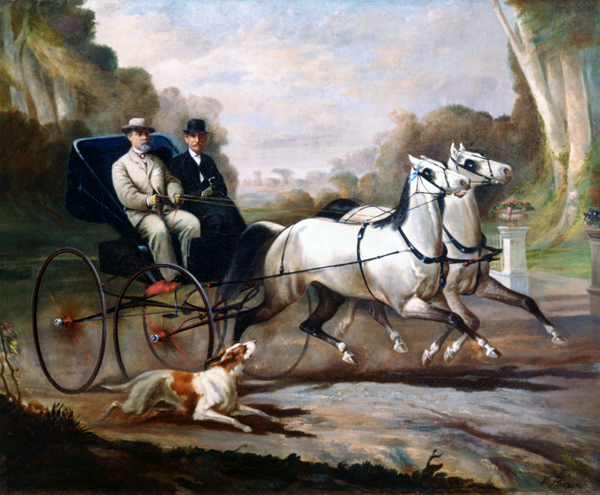Theodore Sydney Moise
In the 1840s Theodore Sydney Moise moved to New Orleans, where he operated a successful portrait studio for decades.

Courtesy of Louisiana State Museum
Victor Pierson and Theodore S. Moise. Pierson, Victor (Artist)
Theodore Sydney Moïse was a painter of people and of horses. He is said to have been one of the first horse painters in the South. A native of Charleston, South Carolina, he moved as a young man to Woodville, Mississippi, and later, in 1842, to New Orleans. From that city, in the pre-Civil War era and during Reconstruction, he traveled throughout the South painting portraits of wealthy landowners and their families, servants, and animals. Two of his best-known portraits are of Senator Henry Clay, commissioned by John Freeland, and of General Andrew Jackson on horseback. (It is speculated that Moïse painted the horse and a colleague rendered the likeness of General Jackson.) Moïse’s popularity is evident in the many portraits of nineteenth-century judges hanging in the Orleans Parish Courthouse in New Orleans. Other paintings can still be found in private homes throughout the South as well as in major museums such as the Metropolitan Museum of Art and the Ogden Museum of Southern Art.
The Early Years
Little is known about Moïse’s artistic education except that he received some training from his aunt, Penina Moïse, a part-time artist. In Charleston he advertised himself not only as a portraitist and animal painter, but as a picture restorer and ornamental draftsman as well. Apparently he carried on these pursuits during his leisure time, as by day he worked in a cotton-factor’s office.
Soon after arriving in New Orleans, Moïse opened a studio with fellow artists Paul Poincy, Benjamin Franklin Reinhart, and Trevor Thomas Fowler. Moïse and Fowler traveled together to neighboring states painting portraits for the wealthy, frequently working collaboratively. Their styles were so similar that critics and art historians sometimes find it difficult to know which artist created a given work. Moïse was a member of the Southern Art Union and exhibited his work at the St. Charles Hotel in New Orleans.
The Paintings
Moïse’s style is described as neoclassical, having characteristics similar to the works of eighteenth-century French artists such as Jean-Auguste-Dominique or Jacques-Louis-David. One of his best-known paintings, Life on the Metairie (1867), a co-commission with British-born painter Victor Pierson, depicts forty-four distinguished New Orleanians at the last meet of the Metairie Race Track. (Life on the Metairie was moved when the Metairie casino closed in 1951 and installed at the New Orleans Fair Grounds Clubhouse, where it was destroyed in a seven-alarm fire in 1993, though it has since been duplicated in that space.) In 1868, Life on the Metairie (in which Moïse painted himself into in the lower-right corner) won first prize at the Louisiana Grand State Fair for best historical painting. Moïse collaborated with Pierson again in 1872 to paint Volunteer Fireman’s Parade, a huge oil painting on canvas showing a ceremony from the vantage point of Royal and Canal streets toward St. Charles Avenue, with Henry Clay’s statue prominently featured.
Personal Life
Theodore Moïse was married to Cecilia F. Moses, granddaughter of Meyer Moses, a member of the South Carolina legislature following the American Revolution. They had one daughter. Moïse’s second wife, Mathilde Vaughn, bore six sons. During the Civil War, Moïse served as a major in the Confederate Army on the staff of General Paul Octave Hébert of Louisiana, primarily designing fire rafts to send against Union ships in the Mississippi River. He died in Natchitoches, Louisiana.
